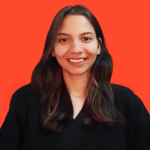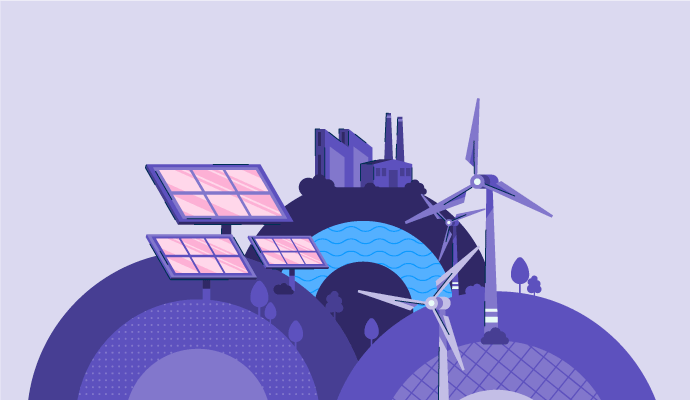July 20, 2023
 by Harshita Tewari / July 20, 2023
by Harshita Tewari / July 20, 2023

Carbon dioxide levels have been increasing in the atmosphere, reaching over 400 ppm. The last time CO2 levels were as high was 4 million years ago. The Greenland and Antarctic ice sheets are losing ice at a rate three times faster than they were 30 years ago.
Burning fossil fuels, like coal, petroleum, and natural gas, is one of the key contributors to the deterioration of climate conditions. Not only do fossil fuels release CO2 into the atmosphere, but they also emit other harmful gasses and particles that further degrade air quality.
As individuals and businesses, we must take immediate steps to rectify the damage we’ve done. Switching to renewable sources of energy and working with energy management tools to oversee energy consumption are two steps that have the potential to make a clima(c)tic difference.
Renewable energy is derived from naturally occurring sources like sunlight, wind, water, and biomass. Unlike fossil fuels, renewable power is environmentally friendly and can be used indefinitely because it’s replenished much faster than we consume it.
As more devastating environmental news surfaces, we can all see we have better options to work with than non-renewable sources. Read on to learn more about renewable energy, its benefits, and the new developments in the clean energy space.
Renewable energy has been turning heads in recent years for several reasons, especially because of its sustainability. While fossil fuels are finite and take millions of years to form, renewable energy resources are replenished naturally and quickly. With the way we burn fossil fuels, we’re going to run out of them sooner than we’re ready.
By switching to renewable energy, individuals and corporations can both contribute to a more livable future that works on resources that don’t carry the risk of depletion, at least while the sun still shines.
Renewable energy sources also have the potential to generate clean energy with minimal or even zero greenhouse gas emissions. Now that’s what the world needs now!
Using renewable energy resources is a sure shot for businesses to position themselves to endure the rapidly changing energy landscape. Using renewable resources, you and your company can reduce carbon emissions and your reliance on the grid, stay motivated, and save money in the long term. As a bonus, consumers and investors will also see your brand in a good light as they become more environmentally conscious, preferring companies that take part in corporate social responsibility.
“A transition to clean energy is about making an investment in our future.”
Gloria Reuben
Actress and Environmental Activist
Using renewable energy doesn’t require digging up the remains of animals and plants that lived millions of years ago. All you need is right outside your door. The different types of renewable energy you can invest in are only beginning to emerge.
At any given moment, the sun gives us more than 173,000 terawatts of solar energy, 10,000 times more than what we need down here on Earth every year. It’s the most abundant of all renewable energy resources and can be converted to electrical energy to run various applications from homes to large-scale factories. Plus, it produces no pollutants!
Harvesting solar energy requires solar panels to capture the sun’s energy, which can be done even in cloudy weather. Solar technologies use photovoltaic panels or mirrors that concentrate solar radiation for electricity production.
Businesses looking into implementing renewable energy should consider investing in solar energy as an alternative since solar panels are cost-efficient and have a lifespan of roughly 30 years.
Wind turbines installed onshore or offshore harness the kinetic energy of wind. Wind power is used to move blades, which, in turn, power a generator and produce electrical energy. The electricity is then converted to a higher voltage and fed into the national grid.
The technology for harnessing wind energy has significantly evolved from traditional wind farms to taller turbines and large rotor diameters to maximize electricity generation. Though wind speed may vary from region to region, the potential for wind energy is enormous.
Did you know? An average wind turbine generates enough energy to power more than 940 average US homes.
Hydroelectric energy or hydropower is the most significant renewable energy source that uses water. Similar in concept to wind energy, the flow of water from high to low elevation is used to move the blades of a turbine, which translates into electrical energy. Hydroelectric power plants can be set up in rivers or reservoirs. The reservoirs are also used for other purposes, such as drought control and the distribution of drinking and irrigation water.
However, hydropower’s infrastructure harms our environment and ecosystems negatively. The workaround so far is to set up small-scale plants in remote locations.
The Earth's heat is probably the last thing you’d think of as an energy source, but it’s pretty common, and humans have been using it for over 100 years. Geothermal energy harnesses the natural heat from Earth's core, which can go up to several thousand degrees Celsius. The decaying radioactive compounds generate this energy; availability is closely related to location.
The heat is extracted using geothermal reservoirs via wells or other means. The wells bring scorching hot water to the surface to turn turbines and generate electricity. Steam and hot water can be pumped back into the source to reduce emissions.
Geothermal power is also used directly for heating purposes through geothermal heat pumps.
Tidal is the second form of hydro energy. As the name suggests, it comes from the natural ebb and flow of the tides. This motion of tides is caused by the gravitational interaction among the sun, the Earth, and the moon. Tidal turbines and barrages are two commonly used methods to harness tidal power.
Tidal barrages are dam-like structures or barriers constructed in estuaries or coastal areas, and tidal turbines are something like underwater wind turbines placed in areas with strong currents. Via both methods, power generation takes place as the tides flow in and out, moving the turbines to generate kinetic energy, which is transitioned into electricity.
A major benefit of tidal energy is that the movement of tides is quite predictable, making it easier to forecast energy production and ensure a consistent power supply. However, it does come with geographical limitations.
Generating bioenergy from plants, wood, crop residue, and other waste is an age-old practice. The different ways biomass energy is produced include combustion, biochemical conversion, and anaerobic digestion.
During combustion, the stockpiled biomass is directly burned and used for water and space heating or generating steam to move turbines to generate electricity. Anaerobic digestion, breaking down organic matter in the absence of oxygen, produces biogas. Biogas primarily comprises carbon dioxide and methane and is used as a transportation fuel or for heating. Biofuels like biodiesel and green diesel are also produced using biomass.
These were some of the renewable energy examples available for exploration. From solar to biomass energy, each source brings its unique set of benefits and potential. By harnessing the power of these sustainable alternatives, we can contribute to a future where energy demands are met without harming our planet.
Renewable energy offers a multitude of benefits, making it an attractive choice for businesses and individuals who care about contributing to a sustainable future while building a positive image and saving money. Let's explore some of the many benefits renewable energy has over traditional fuels.
Let's talk about the disadvantages of renewable energy because while it’s an attractive option with multiple benefits, we have to acknowledge that it has its fair share of drawbacks. A few things to consider before painting yourself green:
Innovation is the need of the hour when it comes to improving our relationship with the environment. Renewable energy companies around the globe have developed technologies that further give green energy the push it requires. From transparent solar panels that disappear into architectural designs to integrating solar energy into powering electric vehicles (EVs), these technologies exemplify the ongoing quest for environmental consciousness.
These panels are a powerful development in photovoltaic technology, with the potential for integration into surfaces like windows, skylights, and screens, making energy generation more efficient and aesthetic. Discovered in 2014, companies like Ubiquitous Energy and Solar Windows are working on increasing the transparency-to-efficiency ratio and making the panels more accessible in the present.
It might sound like sci-fi, but fusion energy aims to replicate the process that powers the sun in order to generate massive amounts of clean and sustainable energy. In large fusion reactors, hydrogen atoms are fused to release an enormous amount of energy.
While it’s still in the experimental phase, significant progress has been made toward making it a reality. In a recent experiment conducted by National Ignition Facility (NIF) at Lawrence Livermore National Laboratory, California, the fusion energy output of 3.15 megajoules far surpassed the ignition threshold from laser energy at 2.05 megajoules. Read more on the experiment here.
This concept involves constructing a chamber submerged in water with an opening facing incoming waves. As the waves enter the chamber, the rising water column creates pressure, which is released through a turbine to generate electricity.
Wave Swell’s device recently completed a year-long run off the coast of King Island, Australia. During this period, its efficiency (how much wave energy was converted to electricity) and availability (percent of time wave energy was converted to electricity) were monitored. CEO Paul Geason reported that UniWave 200 achieved approximately 50% energy efficiency and 80% availability, which is higher than solar panels.
These EVs use solar panels to charge the batteries directly. Typically installed on the roof or body of the vehicle, the solar panels capture sunlight and convert it into electricity, which charges the battery. This technology extends the driving range and reduces the need for external charging.
Solar EVs have been running for a while, with the first model designed by William G. Cobb in 1955. Since then, much work has been done to design cars that run entirely on solar energy. While solar cars still do not match the performance of a traditional vehicle, companies like Aptera, Sono Motors, and Lightyear are making the idea more scalable, affordable, and feasible.
Developed by AWS Ocean, Archimedes Waveswing uses ocean waves to generate electricity. The buoy is tethered to the ocean floor and sits near the water's surface. As waves pass, the buoy rises and falls due to pressure, and a generator uses this up-down movement to produce electricity. More trials are planned in 2023, but the company announced that after six months at sea, their device has managed to beat their expectations by 20%.
Renewable energy is recognized as an integral player in the global energy landscape, with its importance and growth accelerating yearly. Its innovations and trends continue to shape how we generate, store, and utilize clean power as we venture into a technologically advanced but environmentally tenuous age.
 Source: IEA
Source: IEA
“People should have values, so by extension, a company should. And one of the things you do is give back. So how do you give back? We give back through our work in the environment, in running the company on renewable energy. We give back in job creation.”
Tim Cook said it!
The future of renewable energy is promising and filled with transformative possibilities. All we need to do is engage in reducing fossil fuel dependence and stand together to fight climate change. We can build a sustainable energy system for future generations with determination and continued investments in renewable energy.
Did this article get you wondering? Learn more about energy management to maximize energy efficiency and reduce your environmental impact.
Harshita is a Content Marketing Specialist at G2. She holds a Master’s degree in Biotechnology and has worked in the sales and marketing sector for food tech and travel startups. Currently, she specializes in writing content for the ERP persona, covering topics like energy management, IP management, process ERP, and vendor management. In her free time, she can be found snuggled up with her pets, writing poetry, or in the middle of a Netflix binge.
Solar power has emerged as a powerful ally as the world grapples with changing fossil fuel...
 by Conrado Lamas
by Conrado Lamas
It's official: customers choose sustainable products from sustainable brands.
 by Lesley Vos
by Lesley Vos
Sun rays, wind, and water last forever. They won’t exhaust themselves like fossil fuels do....
 by Sagar Joshi
by Sagar Joshi
Solar power has emerged as a powerful ally as the world grapples with changing fossil fuel...
 by Conrado Lamas
by Conrado Lamas
It's official: customers choose sustainable products from sustainable brands.
 by Lesley Vos
by Lesley Vos


